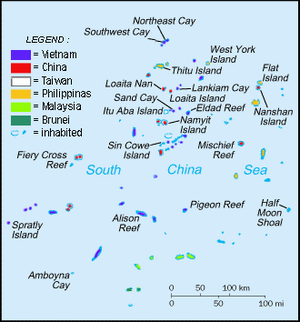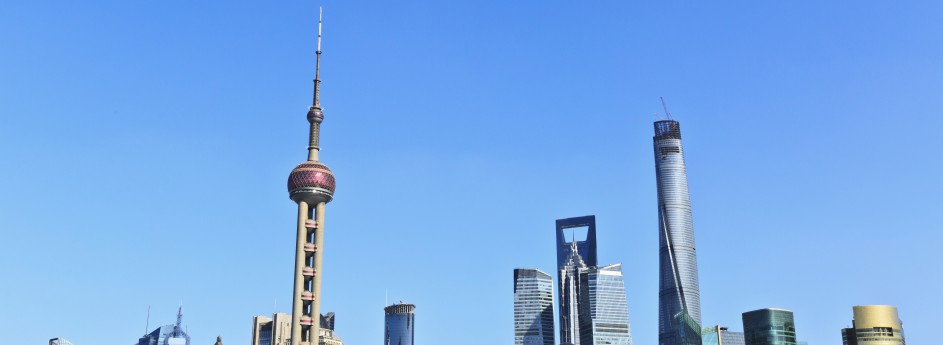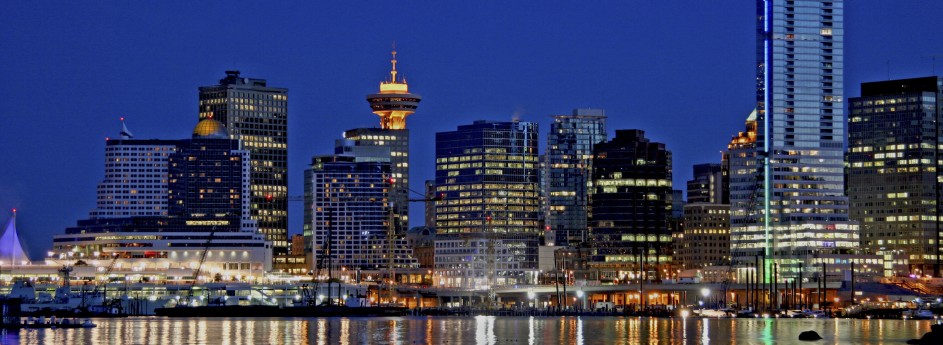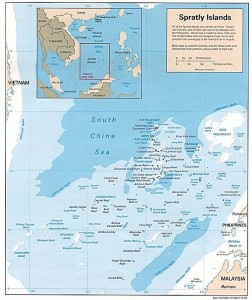Furor Over the Fiery Cross Reef
A report by IHS Jane’s Defence Weekly last week on the building of a suspected airstrip on Fiery Cross Reef has stirred up an international uproar over China’s intentions in the Spratly Islands chain in the South China Sea.
Lying southwest of the main Spratly island archipelago, Fiery Cross Reef, otherwise known as Yongshu Reef in Chinese, is a group of three reefs controlled by China as part of its Sansha Island chain. In 1988, the People’s Liberation Army Navy (PLAN) built a UNESCO Marine observation station there and has since stationed around 200 troops on the reef.  China has been at a disadvantage compared with other claimant countries in the Spratlys as it is the only one without an airfield on an occupied island. Taiwan possesses Itu Abu (Taiping) Island, the Philippines has Thitu (Pasaga) Island, Malaysia occupies Swallow Reef (an airstrip was built on reclaimed land) and Vietnam took Southwest Cay.
China has been at a disadvantage compared with other claimant countries in the Spratlys as it is the only one without an airfield on an occupied island. Taiwan possesses Itu Abu (Taiping) Island, the Philippines has Thitu (Pasaga) Island, Malaysia occupies Swallow Reef (an airstrip was built on reclaimed land) and Vietnam took Southwest Cay.
Airbus Defence and Space satellite images of the island taken on August 8th and three months later on November 14th indicated Chinese dredging had resulted in a new island more than 3,000 meters long and 200-300 meters wide, big enough for a runway and an apron. Along with the runway was a harbor toward the east of the island that looked large enough to take tankers and major war vessels.  According to IHS Jane’s, this land reclamation project is the fourth undertaken by the Chinese in the Spratlys over the past year to 18 months following similar efforts on Johnson South Reef, Cuateron Reef, and Gaven Reefs, none of which were big enough to accommodate an airstrip. The Fiery Cross Reef construction brings China parity with other claimants but also likely considerable concern among them, analyzed Jane’s.
According to IHS Jane’s, this land reclamation project is the fourth undertaken by the Chinese in the Spratlys over the past year to 18 months following similar efforts on Johnson South Reef, Cuateron Reef, and Gaven Reefs, none of which were big enough to accommodate an airstrip. The Fiery Cross Reef construction brings China parity with other claimants but also likely considerable concern among them, analyzed Jane’s.
The journal was quite alarmist in suggesting, “given its massive military advantage over other claimants in terms of quantity and quality of materiel, this facility appears purpose-built to coerce other claimants into relinquishing their claims and possessions or at least provide China with a much stronger negotiating position if talks over the dispute were ever held.”
This latest installment of the ‘China threat’ story got further traction when Jin Zhirui, a colonel with the Chinese Air Force, speaking to reporters at the sidelines of the Xiangshan Forum, China’s answer to other regional defence dialogues, declined to confirm the activities on the reef but nevertheless remarked, “we need to go out, to make our contribution to regional and global peace. We need support like this, including radar and intelligence.”
Almost immediately, the Americans obligatorily called on China to halt the project: “We urge China to stop its land reclamation program, and engage in diplomatic initiatives to encourage all sides to refrain themselves in these sorts of activities, US military Spokesman Lieutenant Colonel Jeffrey Pool urged (quoted by the South China Morning Post). To which Chinese Foreign Ministry spokeswoman Hua Chunying retorted, “I think anyone in the outside world has no right to make irresponsible remarks on China-related activities.”
Air force Colonel Jin pointed to other claimant countries making significant military advances in the area ahead of China. “Although there are 50 islands and reefs in the Nasha Islands, those belonging to China are the fewest in number and China was the last to make advances there”, he said. Interviewed by the Global Times, PLA Major General Luo Yuan added, “The US is obviously biased considering that the Philippines, Malaysia, Vietnam have already set up military facilities….China is likely to withstand the international pressure and continue the construction since it is completely legitimate and justifiable”.
In addition to its occupation of and construction of facilities on Thitu Island, in 1999, the Philippines deliberately ran aground a tattered navy ship, the Number 57 – BRP Sierra Madre, near the Second Thomas Shoal, establishing it as an ‘outpost’ on which troops have been stationed ever since. And numerous flare-ups have occurred between Chinese navy and other ships and their Vietnamese counterparts.
Interestingly, following the disclosure, during a recent round of constitutional arguments on the Philippines’ Enhanced Defence Cooperation Agreement (EDCA) with the US, Associate Justice Antonio Carpio, an ardent anti-China hawk, grilled acting Solicitor General Florin Hilbay to admit that even if EDCA were considered constitutional, there is no guarantee that the country’s protector would come to its aid in case of an external attack. The Aquino government has been trying hard to convince political elites and the public that the country would be protected should push comes to fisticuffs in a showdown with China over the Spratlys.
Naomi Klein Excited About China’s Pledges Under China-US Climate Change Pact
Known for her firebrand critiques of capitalism in her previous works, Naomi Klein’s new book treads similar radical ground in the debate on climate change. In a recent National Geographic interview, Ms Klein shares her views on This Changes Everything. Of particular interest to this blog is her thoughts on the China-US climate change deal. While down on the US side of the bargain, she remains very enthusiastic about China’s commitments viz. renewable energy output. (However, this author is not persuaded by her position against shipping bitumen out of Alberta tar sands, either via the Keystone XL pipeline southward to the US or westward through the Northern Gateway pipeline proposal to the west coast and onward to Asian markets, specially China.)
There’s a new round of climate talks scheduled next year in Paris. How big a setback is the Republican victory in the midterm elections? Conversely, how important is the agreement on emissions between the U.S. and China that’s just been announced?
I think it remains to be seen how much the Republican victory is a setback. It also depends how important a climate legacy is to Obama. And whether the climate movement that came out with such enthusiasm in September can keep up the pressure on Obama. He has the power to say no to Keystone and protect the EPA from political meddling. It’s just a question of whether he wants to—especially in the face of Senator [James] Inhofe occupying one of the most important environmental positions in the country. It can’t be left to a battle between Obama and his conscience. It has to be about counterpressure from this growing movement.
As to the deal with China, the emissions that the U.S. commits to in the China deal are completely inadequate from the perspective of what climate scientists are telling us we need to do if we want to take the two-degree target seriously. We need to be cutting emissions by 8 to 10 percent per year. What this deal promises is 2.8 percent per year by 2025. And that’s not good enough.
The part of the China deal I’m most excited about is to have 20 percent of their energy mix coming from non-fossil fuel sources by 2030 and potentially earlier. We’re already seeing huge investment in clean energy in the PRC. Now they’re talking about doubling their share.
The entire interview can be seen at: http://news.nationalgeographic.com/news/2014/11/141126-keystone-pipeline-indigenous-canada-climate-change-ngbooktalk/
China Drafting New Law to Sanction Deployment of Troops Abroad
Given China’s long-standing principle/policy of not interfering in the domestic politics of other countries, if this law is adopted, it will signal China’s proactivism to take the fight against terrorists to the countries where they are training for anti-China attacks. As China matures as a dominant economic power with vital interests around the world and terrorism increasingly encroaches on Chinese turf, the law may also portend the first baby steps toward the revision of the country’s non-interventionist principle.
The draft of China’s first counter-terrorism law includes clauses that would authorize the army and the paramilitary police to carry out counter-terrorism missions abroad if the deployment had the consent of the countries involved, Chinese delegates told the Xiangshan Forum last week, according to analysts at the regional security meeting.
The draft legislation was submitted to the National People’s Congress Standing Committee in October and is not yet approved, the Hong Kong based South China Morning Post reported yesterday.
Li Wei, a counter-terrorism analyst at the China Institutes of Contemporary International Relations, said the legislation would authorize Chinese troops to fight terrorism beyond its borders.
The new law is being contemplated amid stepped up militant attacks carried out by the East Turkistan Islamic Movement, (ETIM) stated to be a Al Qaeda backed outfit in Xinjiang. A number of ETIM militants were reported to have been killed during air raids carried by Pakistan military in the tribal areas in recent months. Pakistan Prime Minister, Nawaz Sharif during his visit this month promised to step up the crackdown on the militant group. Xinjiang borders Pakistan and Afghanistan.
Li said Chinese troops rarely ventured abroad, with the most recent instance being in 2004 when armed police were sent
to guard the embassy in Iraq.
Renmin University international relations professor Jin Canrong said China was cautious about taking part in overseas operations, given its long-standing principle of non-interference in the internal affairs of other countries. But it was now prepared to be more proactive.
“It’s faced with escalating domestic terrorism threats, which have been proven to be connected to training and other terror activities abroad. Neighbouring countries are also calling on China to help in areas such as training counter-terrorism units and fighting Islamic State,” he said.
– The Economic Times (of India)




